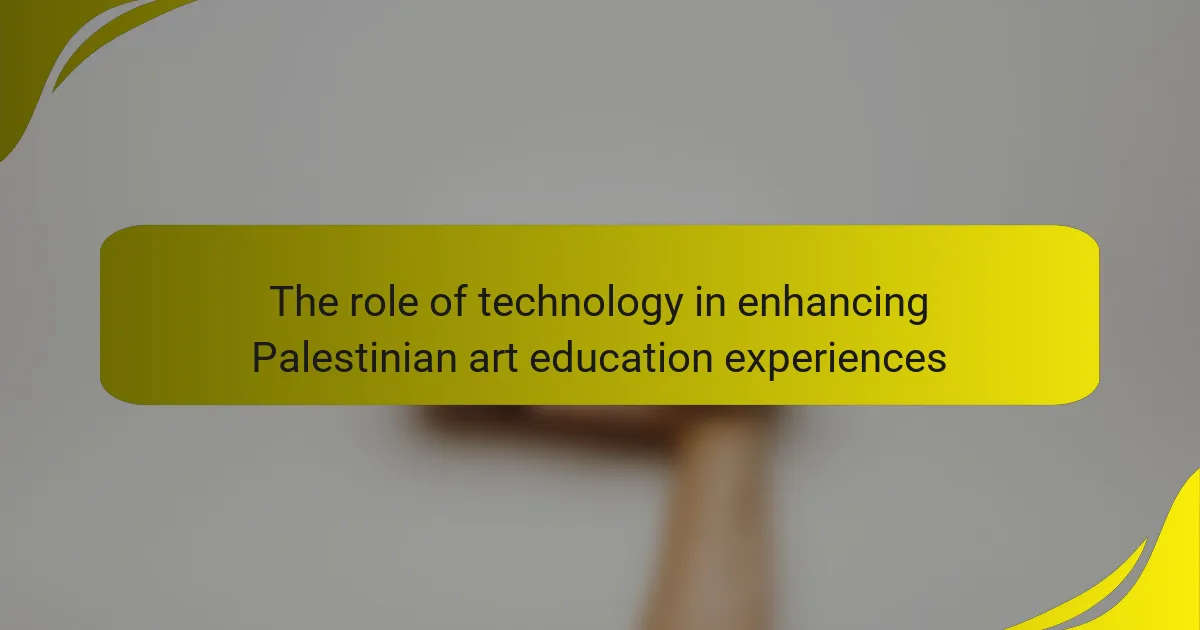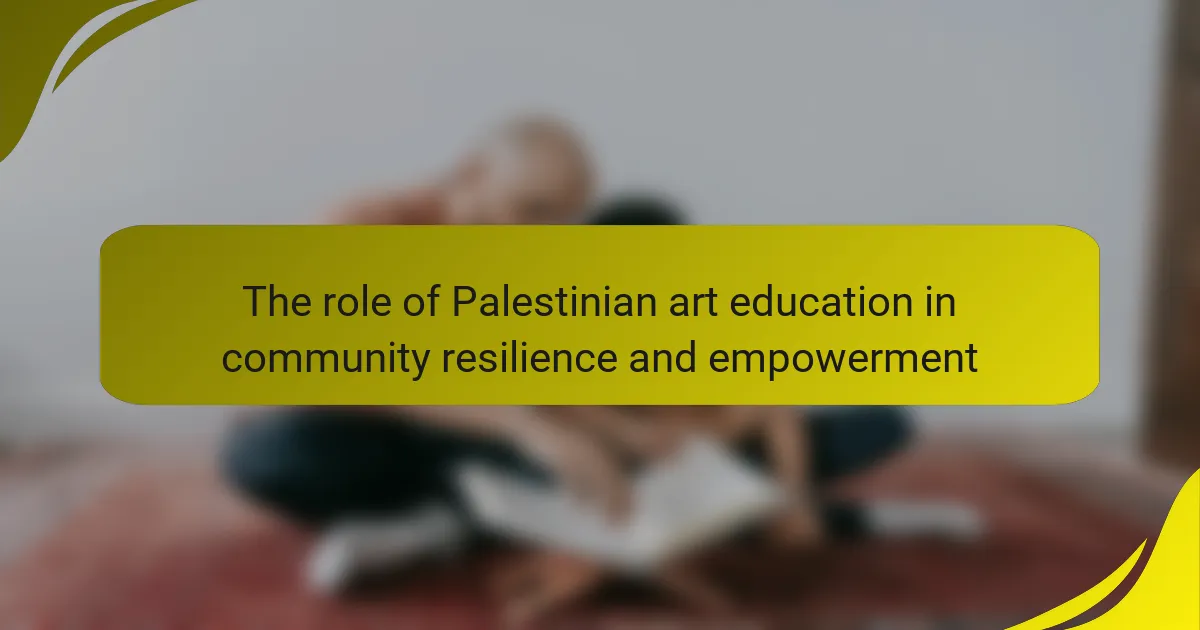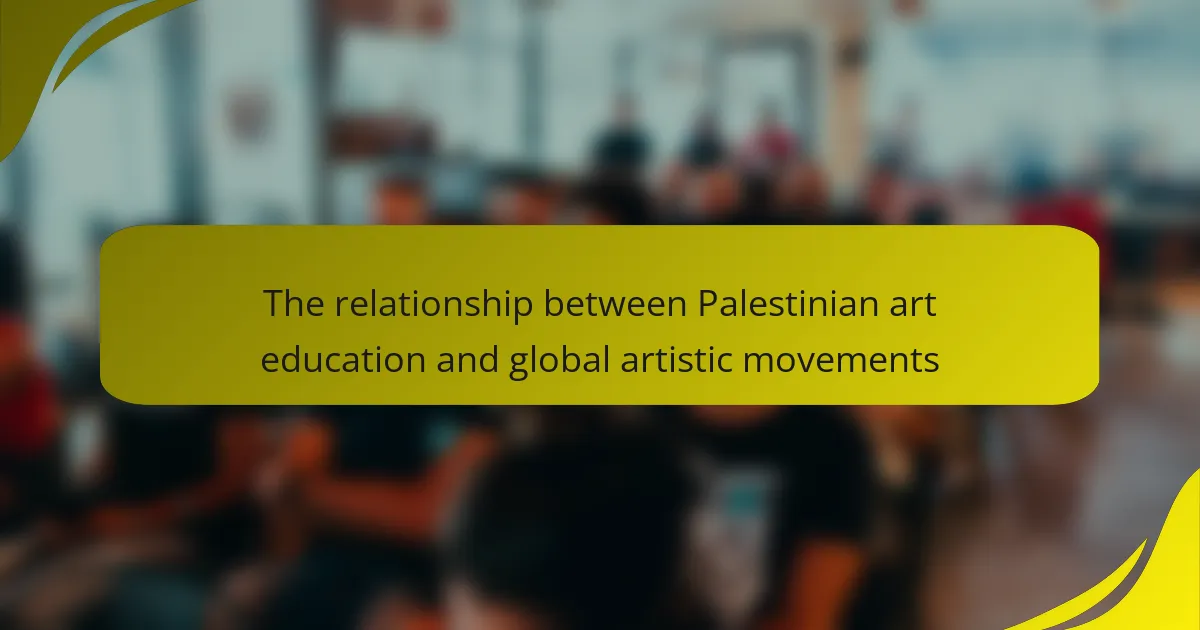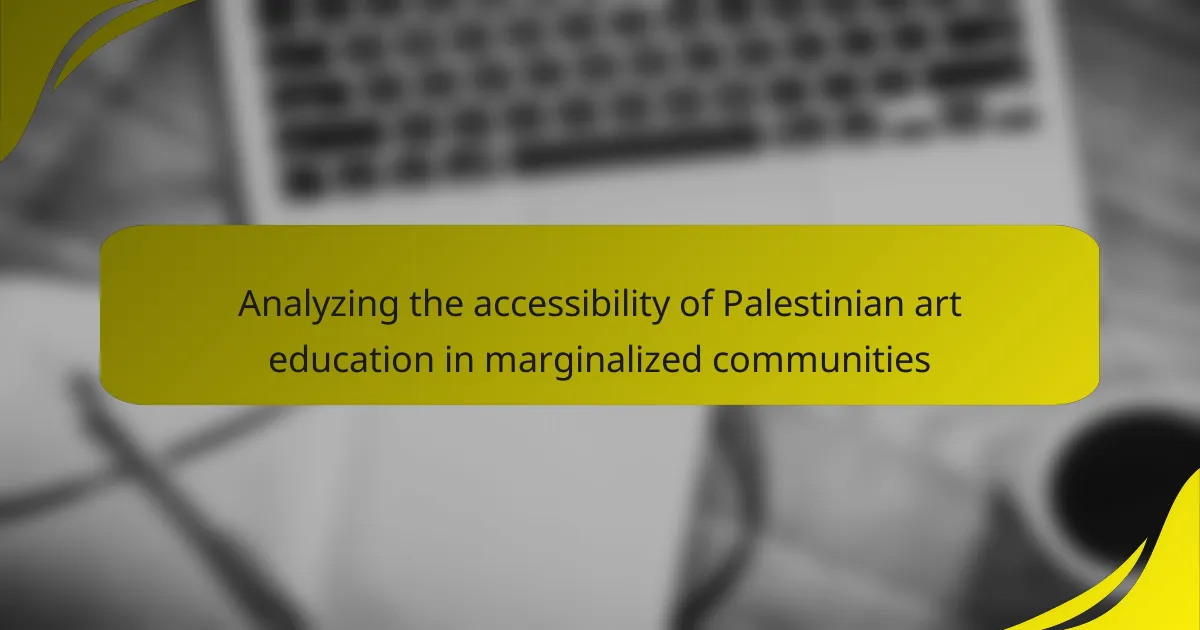Palestinian art education plays a crucial role in enhancing youth engagement and activism. It promotes critical thinking and self-expression, allowing young individuals to address social and political issues through various art forms. This educational approach enables students to explore their identities and cultures, often leading to increased community involvement and activism. Research indicates that participation in art programs correlates with higher rates of civic engagement among youth. The “Art and Social Change” report further emphasizes the positive impact of Palestinian art initiatives on youth activism, empowering them to voice their perspectives and advocate for meaningful change.
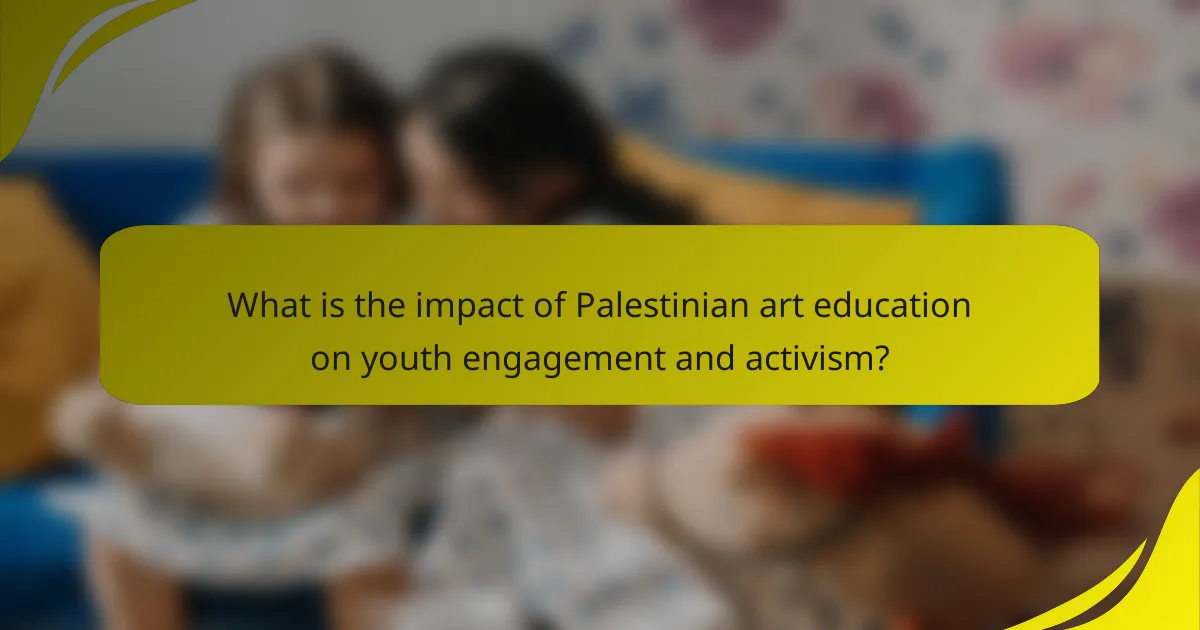
What is the impact of Palestinian art education on youth engagement and activism?
Palestinian art education significantly enhances youth engagement and activism. It fosters critical thinking and self-expression among young individuals. Art education provides a platform for youth to address social and political issues. Through various art forms, students explore their identities and cultures. This exploration often translates into activism and community involvement. Studies show that youth involved in art programs are more likely to participate in civic activities. For instance, the “Art and Social Change” report highlights increased activism among participants in Palestinian art initiatives. Such programs empower youth to voice their perspectives and advocate for change.
How does Palestinian art education influence youth participation in social issues?
Palestinian art education significantly influences youth participation in social issues. It fosters critical thinking and encourages self-expression among young people. Through artistic mediums, students explore and address social injustices. This engagement often leads to increased awareness of local and global issues. Programs like the Al-Quds University Arts Department promote activism through community projects. Research shows that youth involved in art education are more likely to participate in protests and advocacy. Art serves as a powerful tool for communication and mobilization within Palestinian society. The integration of cultural heritage in art education strengthens identity and community bonds.
What specific skills does art education provide to Palestinian youth?
Art education provides Palestinian youth with critical thinking, creativity, and communication skills. These skills enable them to express their identity and cultural heritage. Art education fosters problem-solving abilities through creative processes. It encourages collaboration among peers, enhancing teamwork skills. Additionally, it promotes emotional intelligence by allowing self-expression and reflection. Studies show that engagement in art can improve academic performance and social skills. Art education also cultivates resilience, helping youth navigate challenges in their environment.
How does art serve as a medium for expressing activism among Palestinian youth?
Art serves as a medium for expressing activism among Palestinian youth by providing a platform for their voices and experiences. It allows them to convey messages about their struggles and aspirations creatively. Through visual arts, music, and performance, these youths articulate their political and social issues. Art becomes a form of resistance against oppression and a way to foster solidarity. For instance, murals and graffiti in Palestinian territories often depict themes of resilience and identity. This artistic expression can mobilize communities and raise awareness on both local and global scales. Events like art exhibitions and workshops also encourage youth participation and dialogue. Research indicates that engagement in art fosters critical thinking and empowers youth to advocate for their rights.
Why is art education significant in the context of Palestinian culture?
Art education is significant in the context of Palestinian culture because it fosters cultural identity and resilience. It serves as a medium for self-expression and storytelling among Palestinian youth. Through art, students explore their heritage and express their experiences. This form of education also promotes critical thinking and creativity. It encourages youth to engage with social and political issues. In recent years, art initiatives have gained popularity in Palestinian communities. These initiatives often focus on themes of resistance and hope. Research shows that art education can empower youth to become active participants in their society. This empowerment is crucial in a context marked by conflict and occupation. Thus, art education plays a vital role in shaping a vibrant cultural narrative for Palestinians.
What cultural themes are explored through Palestinian art education?
Palestinian art education explores themes of identity, resistance, and cultural heritage. These themes reflect the historical and social context of Palestine. Identity is expressed through traditional motifs and storytelling. Resistance is portrayed through art that critiques political oppression. Cultural heritage is celebrated by incorporating folklore and historical narratives. Art education facilitates discussions around these themes among youth. This engagement fosters a sense of community and belonging. Moreover, it empowers students to articulate their experiences and perspectives. Such themes are crucial for understanding the Palestinian narrative in a global context.
How does art education reflect the historical context of Palestine?
Art education in Palestine reflects its historical context by integrating themes of resistance and identity. The curriculum often includes elements that address the socio-political struggles faced by Palestinians. This focus helps students understand their cultural heritage and the impact of historical events on their lives. For instance, art programs frequently explore the Nakba and ongoing occupation, fostering critical thinking about these issues.
Moreover, art education serves as a medium for expressing collective memories and aspirations. It encourages youth to engage with their history creatively. Projects may involve community storytelling, which connects personal experiences to broader historical narratives. This approach not only nurtures artistic skills but also promotes social activism.
Research indicates that art engagement enhances youth empowerment in Palestine. A study by the Al-Quds University found that participation in art initiatives increases awareness of social issues among young people. This reflects how art education is intertwined with the historical context of Palestine, shaping informed, active citizens.
What challenges does Palestinian art education face in promoting youth activism?
Palestinian art education faces significant challenges in promoting youth activism. Limited resources hinder access to quality art education. Political instability restricts opportunities for artistic expression. Censorship often stifles critical discourse through art. Socioeconomic barriers prevent youth from participating in art programs. Cultural repression limits the themes and messages that can be explored. Additionally, a lack of institutional support undermines the sustainability of art initiatives. These factors collectively diminish the potential of art education to inspire and mobilize youth for activism.
How do political and social factors affect art education programs?
Political and social factors significantly influence art education programs. These factors shape curriculum content, funding availability, and institutional support. For instance, in politically unstable regions, art education may focus on themes of resistance and identity. Social movements can drive demand for inclusive and diverse representation in art curricula. Additionally, government policies often dictate resource allocation for arts programs. In Palestine, ongoing conflict impacts educational priorities and access to materials. Research shows that art education can foster youth activism and community engagement in politically charged environments.
What resources are necessary for effective art education in Palestine?
Effective art education in Palestine requires access to trained educators, materials, and supportive infrastructure. Trained educators are essential for imparting skills and knowledge. Quality art supplies, such as paints, brushes, and canvases, enhance the learning experience. Additionally, dedicated spaces for art instruction, like studios or classrooms, facilitate creativity. Community support and funding are crucial for sustaining art programs. Access to technology, including computers and software, can aid in modern art practices. Collaboration with local and international organizations can provide resources and expertise. These resources collectively contribute to a robust art education framework that engages youth and fosters activism.
How can the effectiveness of Palestinian art education programs be measured?
The effectiveness of Palestinian art education programs can be measured through various quantitative and qualitative methods. Surveys can assess student engagement and satisfaction levels. Pre- and post-program assessments can evaluate skill development and artistic growth. Attendance rates and participation in exhibitions can indicate program popularity and reach. Feedback from community stakeholders can provide insights into the program’s impact on youth activism. Case studies highlighting individual success stories can illustrate the transformative effects of art education. Research shows that art programs significantly boost youth confidence and community involvement. These measurement strategies ensure a comprehensive evaluation of program effectiveness.
What indicators show increased youth engagement through art education?
Increased youth engagement through art education can be indicated by higher participation rates in art programs. Studies show that when art education is accessible, enrollment numbers often rise significantly. Another indicator is the improvement in students’ self-expression and creativity. Research indicates that students involved in art education report feeling more confident in sharing their ideas. Additionally, increased collaboration among peers during art projects demonstrates enhanced social interaction. Surveys reveal that youth engaged in art education often express a stronger sense of community. Furthermore, the development of critical thinking skills is a notable indicator. Art education encourages students to analyze and interpret various forms of expression, fostering deeper cognitive engagement. Overall, these indicators collectively reflect a positive trend in youth engagement through art education.
How do success stories illustrate the impact of art education on activism?
Success stories illustrate the impact of art education on activism by demonstrating tangible outcomes and personal transformations. For instance, young Palestinian artists have used their skills to address social issues, raising awareness through visual narratives. Programs that integrate art education empower students to express their identities and experiences. This empowerment fosters critical thinking and encourages civic engagement among youth. Evidence shows that participants in art education initiatives report increased confidence and a stronger sense of community. Notable examples include murals created by students that highlight local struggles and aspirations. These artistic expressions often garner attention from local and international audiences, amplifying their messages. Ultimately, success stories reveal how art education serves as a catalyst for activism, inspiring youth to become advocates for change.
What are best practices for enhancing youth engagement through Palestinian art education?
Integrating community-based projects is a best practice for enhancing youth engagement through Palestinian art education. These projects foster a sense of belonging and ownership among participants. Collaborating with local artists can provide mentorship and inspire creativity. Incorporating cultural heritage into the curriculum connects youth with their identity. Offering workshops that focus on various art forms encourages diverse expressions. Providing platforms for showcasing artwork boosts confidence and visibility. Engaging youth in discussions about social issues through art promotes critical thinking. Lastly, utilizing digital tools can expand reach and accessibility for remote learning.
The main entity of this article is Palestinian art education, which plays a crucial role in enhancing youth engagement and activism. The article outlines how art education fosters critical thinking, self-expression, and community involvement among Palestinian youth, enabling them to address social and political issues. It highlights the specific skills gained through art education, such as creativity and communication, and examines the cultural themes explored, including identity and resistance. Additionally, the article discusses the challenges faced by art education programs in Palestine and the resources necessary for their effectiveness, while also providing insights into measuring the impact of these programs on youth activism.
